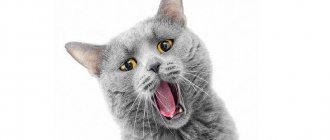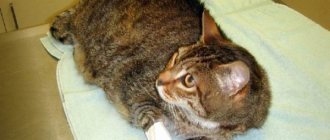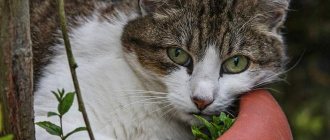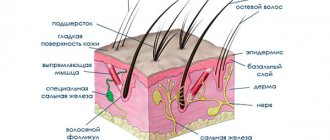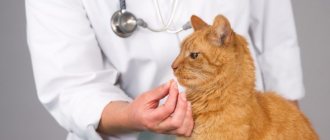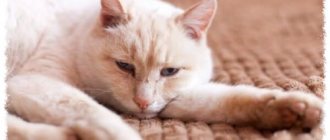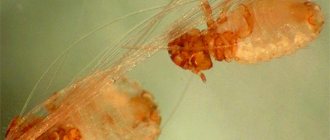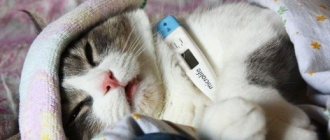If your cat is coughing, it is important to understand what happened to him. The symptom can indicate a variety of problems - from a foreign body getting into the mouth to an asthma attack. A veterinarian can make an accurate diagnosis, and the owner must pay attention to the accompanying signs. This will help to quickly identify the disease and prescribe the correct treatment to the animal.
Main symptoms
It is very easy to identify a cough in your pet. The cat unnaturally stretches its neck forward, tilts its head, and opens its mouth. He coughs with his mouth open, making characteristic sounds. From the outside it may seem that your four-legged pet is vomiting. Most often, vomit is released along with the cough.
If the cough is isolated, then this should not be a cause for concern. With the help of a reflex, the animal simply tries to relieve irritation on its own. It’s another matter if the cough is prolonged, accompanied by other signs, such as snoring and wheezing.
It should be noted that a cat may snore from time to time, for example, when there is a lack of water. She may sometimes experience wheezing - when the animal swallows too large a portion of food.
However, if the above symptoms are presented together and are accompanied by changes in behavior (refusal to eat, restlessness, decreased activity, weight loss, exhaustion, etc.), this is already a reason to visit a veterinary hospital.
How to tell if your cat is choking and not coughing
It is safe to think that the cat has choked if the following picture is observed:
- The cat does not take a characteristic pose (with bent legs, elongated neck).
- There is gagging and wheezing.
- The animal is trying to pull something out of its mouth with its paw. May roll around on the floor and show obvious anxiety.
- Drooling is flowing from the mouth because there is no way to swallow.
This behavior is usually preceded by eating or playing with small objects.
Helminths
Worms that appear in the body irritate the mucous membrane, causing a cough. This is often accompanied by weight loss, vomiting and dandruff. To combat them, the pet is given antihelminthic medications. In severe cases, they are given again a week after the first dose. Delay can lead to problems with the liver, kidneys and even death.
Trichobezoars, coughing up hair
Cats groom themselves by licking their fur coat with their tongue. That, in turn, can enter the digestive organs. The lumps formed there provoke coughing. It doesn't pose a threat. A paste that dissolves lumps or special food will help.
To measure the temperature
Throat injuries
They also irritate the larynx. Sores and ulcers can be a sign of chlamydia, which people can become infected with.
Heart diseases
Cardiac cough gradually intensifies and is accompanied by lethargy, shortness of breath, and heavy breathing. A cardiogram will confirm this version.
Respiratory diseases
These include viral, bacterial, and fungal infections. Immediately the cough is dry and loud. On the second day, sputum separates and he becomes deaf. In addition, nasal discharge, rotting of the eyes, weakness, and increased body temperature appear.
Can cats get kennel infections from dogs?
In dogs, infection with various bacteria and viruses can lead to kennel cough. Bordetella bronchiseptica, mycoplasma, parainfluenza virus, adenovirus type 2, canine coronavirus and others are to blame - individually or in combination.
Cats are susceptible to some of these pathogens, such as Bordetella, but not others. To prevent possible spread, any pet that is sneezing, coughing, or has discharge from the eyes or nose should be isolated from other pets and examined by a veterinarian.
Types of cough
Just like in humans, a cat’s cough is characterized by several criteria, thus being divided into types:
By duration:
- Chronic – lasts for months;
- acute – lasts several days.
By the nature of the discharge:
- wet;
- dry.
By volume:
- muted;
- weak;
- voiced.
By intensity:
- easy;
- hysterical, leading to vomiting.
By time of day:
- morning;
- evening.
By season:
- spring;
- autumn, etc.
When you observe your pet's cough, try to determine its type based on these parameters, so that you can then provide the doctor with a complete picture of the disease. Also pay attention to the time of day at which the cough peaks.
Who coughs and wheezes: what is the danger, symptoms, insidious and different
An attentive owner should have noticed that the cat’s cough has a different sound color.
. Sometimes it's wheezing, sometimes it's a continuous dry sound full of agony. If you record cough sounds on a voice recorder or video camera, this can greatly help the doctor in diagnosing the disease. Sometimes the owner's description is not very accurate. Among other things, cough can be morning, daytime, evening or night. Coughing at night causes a lot of trouble both for the cat, depriving it primarily of normal sleep, and for the owner, who begins to worry about the health of his furry friend.
During a coughing attack the animal
It can also stretch out its paws and can group itself.
These signals indicate that this sound has gone from a reflex, which is designed to save life, to a very dangerous state that poses a direct threat to the cat. In especially severe cases, the animal may choke , which indicates that the owner needs to contact a veterinary center as soon as possible.
Treatment of cough at home
Therapy is determined by the complexity of the pathological process and is aimed at eliminating it:
- For invasive cough, antiparasitic procedures are prescribed, and in the future it is recommended to regularly prevent the disease.
- Attacks due to cardiac problems are eliminated by comprehensive treatment of the cardiovascular system and general cough suppressants.
- The specificity of antiviral and antibacterial therapy is determined by the characteristics of the cough: expectorants are prescribed for dry coughs, and antitussives for wet coughs.
- Asthmatic attacks are stopped by hormonal and glucocorticosteroid, antiallergic drugs.
- Special creams and pastes improve the condition of trichobezoar They cover the surface of hairballs and facilitate their natural release.
- Cough from injuries to the respiratory organs and throat subsides as they heal. If internal organs are injured, the pet is given crushed food. For external wounds, treatment methods depend on the severity of the pathology. In serious situations, the wound is surgically sutured and antibacterial therapy is carried out.
Treatment
The goal of any treatment procedure to combat cough is to eliminate the cause that caused it:
- For helminthic infestations, drugs that destroy worms are prescribed. Prevention – regular deworming.
- If cardiac pathologies are detected, the functioning of the heart and vascular system is stabilized. The cat is put on a special diet.
- To treat respiratory infections, antiviral agents and antibiotics are prescribed, depending on the specific disease.
- There is no way to completely cure asthma. Lifelong therapy is indicated for the animal. Corticosteroids are recommended to relieve swelling and inflammation, and bronchodilators are recommended to ease breathing.
- If the cause of cough spasms is trichobezoars, special pastes or a diet are prescribed that facilitate the removal of hair from the stomach naturally.
- When the injuries and scratches from the bones heal, the soreness and cough go away. Therefore, only nutritional recommendations are given. During the recovery period, the animal is switched to soft food.
Diagnostics
Having studied the external symptoms of cough, we proceed to diagnosis:
- conduct an external examination of the body, listen for wheezing and noises;
- evaluate cardiac activity;
- take blood for analysis;
- do an X-ray examination of the sternum;
- a culture of secretions or sputum is collected to identify the causative agent of inflammation;
- examine the affected organ for oncology (if suspected).
In clinics, it is possible to examine the entire animal’s body by different specialists and conduct an X-ray examination with a contrast agent.
How to treat
After determining the provoking factors, appropriate treatment is prescribed. Using medications without consultation with a specialist can cause negative consequences. The wrong choice of medication or its dosage can lead to complications. However, it is very useful to familiarize yourself with general information about existing drugs. In some cases, you can use tablets intended for humans. It is not recommended to give syrups due to the large amount of sugar, dyes, and flavors they contain. Medicines containing codeine and alcohol are also not allowed.
Blocking substances help to quickly eliminate attacks, but do not affect its source. Therefore, they can be given to your pet only in combination with other means. Expectorants do an excellent job of treating infectious coughs by thinning mucus and removing it from the respiratory tract.
How to treat a cough
Diagnosis of the condition
The multiplicity of causes that can cause cat cough makes it very difficult to diagnose cats. Therefore, the veterinary specialist consistently conducts a series of studies, including:
- collection of anamnestic data;
- inspection;
- palpation;
- percussion;
- auscultation;
- general and clinical blood test;
- radiography;
- coprogram for identifying intestinal helminth eggs.
If it is not immediately possible to determine the reason why the cat cannot cough, the veterinarian will prescribe additional laboratory and instrumental tests.
Note! Only large veterinary clinics can afford additional research, and the cost of these services is quite high. Therefore, it is advisable to carry them out more often for such high-pedigreed “expensive” cats as Sphynx, Maine Coon, Peterbald, Scottish Fold and others.
Specific additional studies that will help determine exactly why a cat is coughing with wheezing include:
- sputum analysis for the presence of viral agents and their identification;
- fluoroscopy of the esophagus using a contrast indicator;
- endoscopy of the upper respiratory tract and esophagus;
- bronchoalveolar lavage (performed under general anesthesia).
If the doctor suspects that the cat cannot cough due to the development of pathology of the cardiovascular system, the doctor will prescribe an ECG or ultrasound of the heart.
How to treat cat cough
If a cat is coughing, it can be treated at home only after being examined at a veterinary clinic, making an accurate diagnosis and prescribing appropriate therapy.
You should not self-administer cough suppressants before visiting a doctor, as this may change the clinical picture of the disease and make it difficult to determine the cause of the pathology.
Important! If the cat is coughing and wheezing, as if he is choking, then you should not take any independent action. It is better to quickly take your pet to the hospital or call a doctor at home. Delay can also be fatal when the cat wheezes, trying to burp, but only spits up saliva or foamy liquid.
If a cat coughs due to an infectious disease of viral etiology, the doctor prescribes:
- antibacterial drugs (Amoxisan, Sinulox, Tsiprovet) to prevent the development of secondary bacterial infections;
- mucolytic and expectorants (Bromhexine, licorice extract);
- immunomodulators (Cycloferon, Fosprenil, Maxidin);
- globulin Vitafel;
- intravenous injections of Ringer-Locke solution or saline with 5% glucose (to prevent dehydration when refusing food).
If the cough is accompanied by wheezing and the cat coughs while stretching its neck, then the cause may be pneumonia or another inflammatory process in the respiratory system. In this case, antibiotics are first prescribed. And to relieve coughing, the cat should be given antispasmodics, mucolytics and expectorants.
If a cat's cough is accompanied by vomiting, this often indicates helminthiasis. In this case, anthelmintic drugs are prescribed (Pyrantel, Prazicide, Drontal, Milbemax). Despite the fact that these medications are sold in pharmacies without a prescription, you should not use them yourself if your cat wheezes and tries to burp.
In case of severe infestation, an incorrectly selected dosage can lead to excessive activity of parasites and lead to suffocation. Illiterate actions by owners can also lead to intestinal rupture or excessive intoxication in small kittens.
If the reason that the cat is coughing and stretching its neck, as if choking, is trichobezoars, then the doctor will prescribe special pastes and gels to remove or dissolve hairballs in the stomach.
If a cat coughs and wheezes with its tongue hanging out, this may indicate an attack of bronchial asthma. You can quickly relieve an attack with:
- glucocorticosteroids (Hydrocortisone, Prednisolone, Dexamethasone, Fluocinolone);
- bronchodilators (Theophylline, Atropine);
- antibiotics (if there is a threat of infection by pathogenic bacteria).
Important! Self-administration of glucocorticosteroid and bronchodilator drugs to treat Sphynxes and other cats when they cough while stretching their necks can lead to overdose, complications and the development of side effects. Therefore, you should not put your pet’s life at risk; you must urgently take him to the clinic.
The reason that the cat is coughing, wheezing, as if he is choking, may be a heart attack, which develops in the cat as a result of a hidden pathology of the cardiovascular system. In this case, any independent treatment is unacceptable.
You should immediately call the clinic, call a veterinary specialist to your home and get a recommendation on the actions that need to be taken before his arrival.
Heart problems
Many people do not know what to do if a cat coughs and wheezes, for what reason this reflex occurs. A serious reason to see a doctor is the occurrence of heart problems. Most often, this disease occurs in old and overweight animals. At first, coughing rarely bothers the animal, but later it inevitably becomes more frequent.
The disease is diagnosed by tactile and visual examination. The pet's blood pressure is measured, electrocardiography and radiography are performed. Such a disease requires lifelong care for the animal and maintenance therapy. Treatment is prescribed by a veterinarian based on the research results obtained. Giving medications at your own discretion is strictly prohibited.
The cat must be provided with rest, proper nutrition and follow the doctor's instructions. For animals with this pathology, special dietary foods are sold in pharmacies.
Preventive measures
Carefully following your veterinarian's instructions will help prevent coughing attacks. If an animal has chronic diseases (bronchial asthma, fungal pneumonia), it is necessary to promptly give it immunomodulatory, antifungal drugs and vitamin complexes. It is recommended to take a blood test 1-2 times a year to confirm the absence of hidden ailments.
Preventive administration of anti-worm medications will help prevent helminthic infestation. They are given every 3 months, choosing products with the softest and most gentle composition. Kittens, pregnant and elderly cats, as well as animals with free access to the street are at particular risk.
If coughing attacks occur while eating, you should review your pet's menu. It is better to replace hard granules with canned food. Soaking ready-made dry food in water also helps. Cats that eat natural food should not be given river fish with bones on which the cat can choke. Tubular chicken bones are strictly prohibited. If your cat likes to chew, it is better to give her ready-made toys made from beef veins, which can be bought at a pet store.
It is necessary to remove from the house easily breakable toys, Christmas tree tinsel and other items that the animal can swallow. It is recommended to remove poisonous indoor plants. An accidentally bitten leaf can cause swelling of the mucous membrane and an attack of suffocation.
Only a veterinarian can understand why a cat is coughing and what to do. If attacks occur repeatedly and are accompanied by other alarming symptoms, you should not postpone a visit to the clinic. They will do all the necessary tests and prescribe adequate treatment that will help maintain the health of your pet.
Types of cough depending on the cause
Cough has many varieties. To treat it, it is important to identify the irritant. Depending on the cause, different associated symptoms will be observed.
Allergic
Seasonality of attacks is typical for pollen allergies. An allergic reaction is accompanied by discolored discharge from the nose, redness of the eyes, or hair loss.
Allergens also include food, fillers, household chemicals, dust, tobacco and other irritants. Try eliminating the options listed and observe the reaction.
Asthmatic
Bronchial asthma is a chronic disease of the respiratory tract. It occurs with prolonged exposure to allergens in animals over 3 years of age.
Unlike allergies, asthma attacks occur progressively. At first, the cat coughs as if she was choking, and a week later she loses consciousness and faints due to lack of oxygen. Swelling of the mucous membrane blocks the glottis and prevents normal air circulation. Pathology can be suspected based on the following signs:
- dry cough lasting more than a week;
- gradual increase in attacks;
- the appearance of shortness of breath;
- no increase in temperature;
- blueness of mucous membranes;
- increased drowsiness.
If you notice any of these symptoms, contact your veterinarian. Delay in case of bronchial asthma is unacceptable, as it can result in the death of the animal.
Viral
Colds in cats caused by hypothermia are rare. Most often, the reason that a cat is coughing as if he is choking is due to a viral infection. When infected with viruses, the symptoms are supplemented by:
- loss of appetite or complete refusal to feed;
- wheezing and vomiting;
- increased body temperature;
- lethargy and apathy;
- the appearance of serous-purulent discharge from the eyes;
- runny nose and drooling;
- formation of ulcers in the oral cavity.
Possible diagnoses include calcivirosis and rhinotracheitis. When prolonged, they lead to pneumonia, numerous ulcers and blindness. Kittens under six months of age suffer the most severe diseases - among them the mortality rate from viruses is very high.
Infection with worms
If your pet cannot cough for a long time, check it for parasites. Lungworms easily penetrate the body of even couch potatoes. They get inside an animal when it eats contaminated food or an intermediate host (mouse, insect, bird).
Inside the host's body, the parasite travels the full route, moving through the bloodstream from the intestines directly to the lungs. When re-swallowed, the cough reflex causes the worms to rush back into the small intestine, where they develop into adults. There they lay eggs, and the cycle repeats again.
Helminthiases are accompanied by:
- lethargy and apathy;
- enlarged abdomen;
- the appearance of dull and tousled fur;
- blanching of mucous membranes;
- frequent vomiting, diarrhea, bloating or belching;
- dandruff formation;
- weight loss while maintaining appetite;
- the presence of mucus, blood or parasites in the stool.
If these symptoms are detected, it is recommended to immediately consult a veterinarian. Self-medication can lead to severe intoxication of the body and death of the animal.
Foreign object or coughing up fur
Sometimes a cat coughs, as if choking, after swallowing a foreign object. Using the cough reflex, she tries to remove the stuck body from the trachea and larynx. Foreign objects entering the respiratory tract occur when:
- chewing bones or toys;
- artificial feeding through a syringe;
- regurgitation and vomiting;
- hasty eating;
- forced intake of large medications in capsule or tablet form.
Swallowing sharp or large objects increases the likelihood of internal injuries. If the object is firmly lodged in the depths of the larynx, you will have to resort to surgical intervention. Otherwise, the cat may die from suffocation.
In addition to foreign objects, the cause may lie in trichobezoars, that is, hairballs. They accumulate in the stomach after licking. One part of the lumps comes out with feces, the other dissolves in gastric juice. If there is excessive accumulation of trichobezoars, they begin to irritate the gastric walls, activating the cough reflex. You can help the animal by feeding it herbs or a special paste - then the cat will vomit hair and the cough will stop.
Asthma attacks
Bronchial asthma is a chronic disease of the respiratory tract. It is allergic in nature and is not associated with bacterial growth. The nature of development is most often genetic, but sometimes acquired pathologies occur. The signs of the disease are as follows:
- severe coughing attack;
- dyspnea;
- restless state;
- hoarse breathing;
- pronounced cyanosis is visible on the mucous membranes;
- increased drowsiness;
- refusal of food;
- the pet takes a forced position - lowers its head and stretches its neck, trying to cough up phlegm;
- in severe cases, eye rolling and loss of consciousness may occur.
To accurately establish a diagnosis, tests are taken from the animal, a hardware examination of the abdominal and chest cavity is performed, and then treatment is prescribed. It includes taking antispasmodics, antibacterial drugs, as well as vitamin complexes, especially vitamins C and E, which are natural antioxidants. It is also recommended to purchase an inhaler that will help relieve the attack and prevent your pet from suffocating.
Types and symptoms of cough in cats
The classification of cough in cats is described in detail in the table.
| Characteristics of cough | Degrees and types of cough manifestations |
| Force | slight cough; hacking cough |
| Form depending on duration | acute (less than 14 days); prolonged (from 14 to 45 days); chronic |
| Timbre | silent; voiced; deaf; hoarse; hoarse; barking |
| Presence of discharge | dry; wet |
| Character of sputum | serous; slimy; purulent; mixed with blood |
| Development time | constant; seasonal |
Symptoms that most often accompany coughing in cats include:
- discharge from the nasal cavity;
- vomit;
- wheezing.
The nature of the cough helps specialists make the correct diagnosis, identify the causes and prescribe appropriate treatment for a coughing cat.
What makes a cat cough
Cough in cats can be divided into 2 types:
- Reflex when it is a reaction to stimuli.
- Symptomatic, when the act of coughing is a symptom of some disease, and not a separate disease.
A cough spasm occurs if an animal has inhaled caustic gases, smoke, or odorous aerosols. The most common cause of a reflex cough is the entry of foreign particles into the larynx or trachea. And also if foreign objects are in the esophagus or pharynx and put pressure on the trachea and larynx. The cat coughs and wheezes, stretching out and pressing herself to the floor, as if she had choked. She will cough until the foreign object is coughed up or until it is removed. If foreign objects are in other areas, then the cough cannot be caused.
The causes of symptomatic cough are more varied. Doctors name more than 50 diseases, one of the symptoms of which is cough.
Symptoms and diagnosis
The list of symptoms is usually typical and includes the following manifestations:
- Cough - dry or wet, with sputum.
- Difficulty breathing, accompanied by extraneous sounds.
- Shortness of breath even after minor physical exertion.
- Decreased appetite.
- Lethargy, changes in behavior.
- Excessive salivation, irritation of mucous membranes.
If coughing or wheezing is caused by an infectious disease, then signs of an inflammatory process such as fever are added to the symptoms.
Diagnosis is made based on an assessment of symptoms. Its main task is to determine the cause of wheezing and coughing for further relief. After collecting anamnesis and examining the animal, the veterinarian may prescribe:
- Blood analysis.
- Stool analysis to detect lungworms.
- Analysis of tracheal swabs.
- Chest X-ray.
If it is difficult to make a diagnosis, other examinations may be performed.
Respiratory diseases
A common cold can easily provoke coughing, sneezing, swelling of the mucous membranes, and discharge of pus from the nasal passages and eyes. During this period, it is difficult for the pet to swallow, which is why he stops eating and even drinking. Inflamed airways, fortunately, are easy to treat.
The disease is eliminated with the help of antiviral, antibacterial medications, as well as expectorants or antitussives, which are prescribed depending on the type of cough. To restore and subsequently strengthen the animal’s immunity, the veterinarian prescribes a vitamin complex. As a preventive measure , you should take your cat for vaccination , which will reduce the risk of a serious disease.
